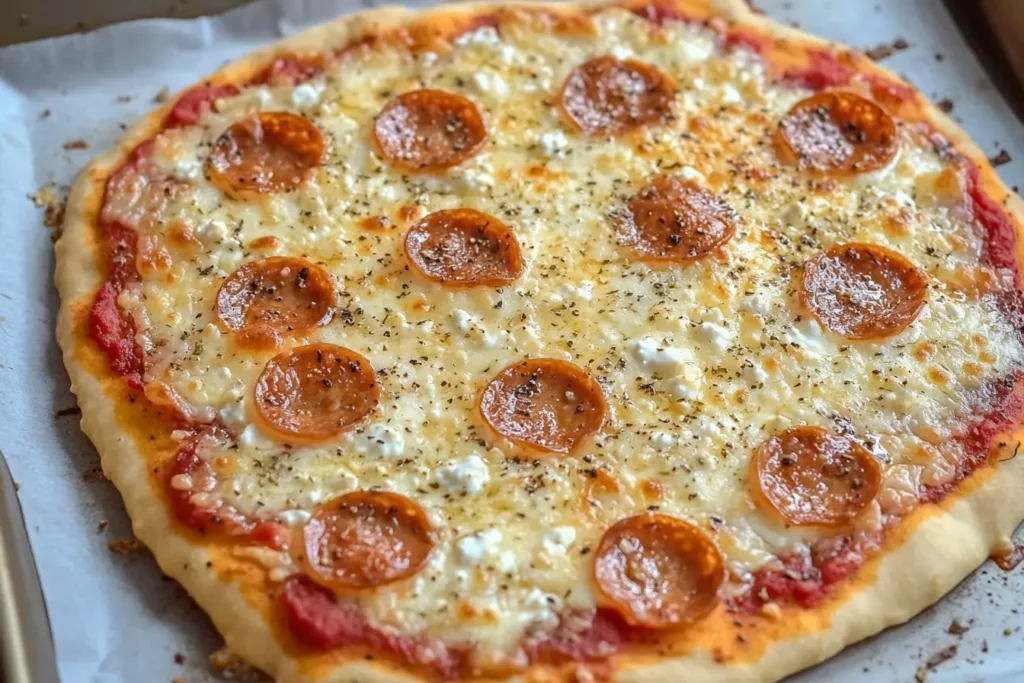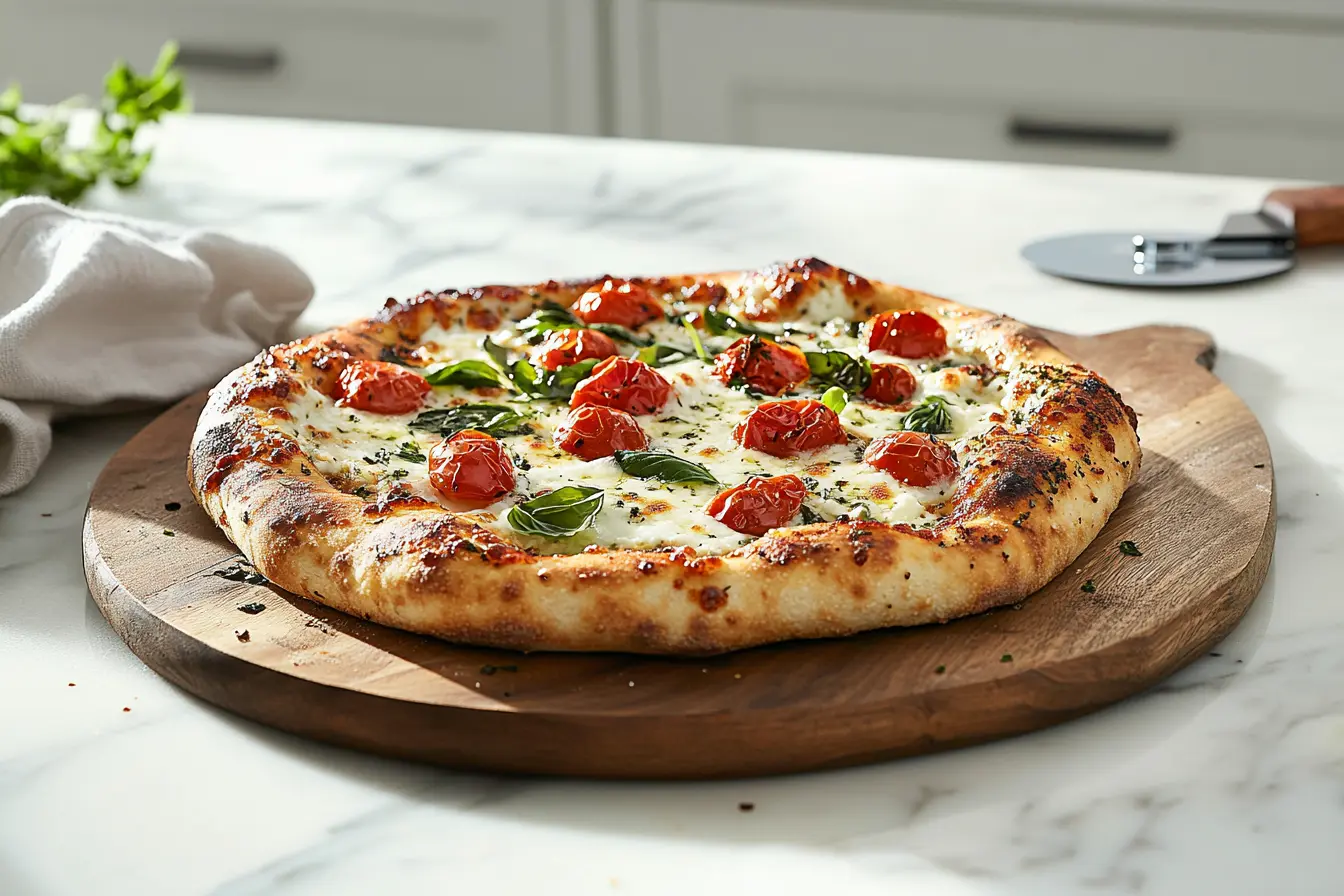I remember when girls, were toddlers, getting them to eat anything remotely healthy was a battle. Pizza was always a winner, but I wanted a healthier crust option. One evening, I decided to experiment with cottage cheese pizza crust after reading about its nutritional benefits. The result? A crispy, delicious crust that surprised even me!
I was even more amazed when Lily and Mia gobbled it down without a single complaint. They loved it! Since then, cottage cheese pizza crust has become a weekly staple in our house. It’s perfect for sneaking in extra protein and calcium, which is a win for this mom.
Why this Cottage Cheese Pizza Crust Is Special
This cottage cheese pizza crust isn’t just a healthier alternative; it’s incredibly versatile. I can customize it with our favorite herbs and spices, and the high protein content from the cottage cheese creates a satisfyingly crispy crust. It holds all our favorite pizza toppings beautifully!

Ingredients for the cottage cheese pizza crust
This cottage cheese pizza crust is surprisingly simple to make with just a few everyday ingredients. Here’s what you’ll need:
Core Ingredients
- 1 cup cottage cheese (small curd or blended)
- 2 large eggs
- ½ cup grated Parmesan cheese
- ¾ cup almond flour (or other alternatives – I’ll share more on this later!)
- 1 teaspoon baking powder
- 1 tablespoon olive oil
- 1 teaspoon Italian seasoning (or your preferred herbs)
- ½ teaspoon salt
- ¼ teaspoon black pepper
Optional Add-ins
- ½ teaspoon garlic powder
- ½ teaspoon onion powder
- ½ teaspoon dried oregano
- ¼ teaspoon red pepper flakes (for a little kick!)
- 1 tablespoon finely chopped fresh herbs (like basil or parsley)

Instructions to make the cottage cheese pizza crust
Let’s get started making this delicious and healthy pizza crust!
Preparing the Cottage Cheese
If you’re using small-curd cottage cheese, you can use it straight from the container. However, I prefer a smoother crust, so I blend my cottage cheese for a few seconds in a blender or food processor until it’s creamy. If you’re using large-curd cottage cheese, blending is a must! No need to drain the cottage cheese beforehand. The moisture content is important for the dough.
Mixing the Dough
Preheat your oven to 400°F (200°C). In a large bowl, whisk together the eggs, Parmesan cheese, olive oil, Italian seasoning, salt, and pepper. Add the blended cottage cheese to the bowl and mix well. In a separate bowl, combine the almond flour and baking powder. Gradually add the dry ingredients to the wet ingredients, mixing until just combined. Don’t overmix! The dough will be slightly sticky, but that’s perfectly normal.
Pre-baking the Crust
Line a baking sheet or pizza pan with parchment paper. This is key for easy cleanup and a crispy crust. Transfer the dough to the prepared baking sheet and spread it out into your desired pizza shape (round or rectangular). I aim for about a ¼-inch thickness. Pre-bake the crust for 15-20 minutes, or until it’s lightly golden and the edges start to firm up. This pre-baking step helps create that wonderfully crispy crust and prevents a soggy bottom when you add your toppings.
Adding Toppings and Final Baking
Once the crust is pre-baked, remove it from the oven. Now comes the fun part! Add your favorite pizza sauce, cheese, and toppings. I love classic combinations like pepperoni and mushrooms, but get creative! After adding your toppings, return the pizza to the oven and bake for another 10-15 minutes, or until the cheese is melted and bubbly and the toppings are cooked through. Keep a close eye on it to prevent burning. Let the pizza cool slightly before slicing and serving. Enjoy!

Tips and Variations
Here are a few tips and variations to help you customize your cottage cheese pizza crust and make it your own.
Achieving the Perfect Crispy Crust
For an extra crispy crust, make sure you pre-bake it thoroughly. Don’t rush this step! A slightly longer pre-baking time will ensure a sturdy base for your toppings. Using parchment paper is essential to prevent sticking and promote even browning. If you like a really thin and crispy crust, you can increase the oven temperature to 425°F (220°C) for the final bake, but watch it closely to avoid burning.
Flavor Combinations
The basic recipe is delicious, but feel free to experiment with different flavors! For a garlicky parmesan crust, add extra parmesan and garlic powder to the dough. If you love Italian herbs, add a pinch of oregano, basil, and rosemary. For a spicy kick, add red pepper flakes or a dash of cayenne pepper to the dough. The possibilities are endless!
Gluten-Free Options
To make this recipe gluten-free, simply substitute the almond flour with a gluten-free flour blend. I’ve had good results with a combination of almond flour and coconut flour. You can also use oat flour (make sure it’s certified gluten-free) or a gluten-free all-purpose baking mix. Just keep in mind that the texture of the crust might vary slightly depending on the flour you use.
Making Ahead and Storing
You can make the cottage cheese pizza crust ahead of time and store it in the refrigerator for up to 2 days. Wrap it tightly in plastic wrap or store it in an airtight container. When you’re ready to use it, simply add your toppings and bake as directed. Leftover pizza can be stored in the refrigerator for up to 3 days. Reheat individual slices in a toaster oven or skillet for the best results.
Nutritional Information of the cottage cheese pizza crust
This cottage cheese pizza crust is not only delicious but also packs a nutritional punch. Here’s a breakdown of the approximate nutritional values per serving (one-sixth of a typical pizza crust):
Macronutrients
- Protein: This crust is a protein powerhouse! One serving provides approximately 15-20 grams of protein, thanks to the cottage cheese. This helps keep you feeling full and satisfied.
- Carbohydrates: A serving contains around 10-15 grams of carbohydrates, primarily from the almond flour.
- Fat: Each serving has about 10-15 grams of fat, mostly healthy fats from the almond flour and olive oil.
Please note that these values are estimates and may vary based on specific ingredients and portion sizes.
Micronutrients
Cottage cheese is a good source of calcium, essential for strong bones and teeth. This crust also provides a decent amount of selenium, a mineral with antioxidant properties. Additionally, you’ll get small amounts of other essential vitamins and minerals like vitamin B12, phosphorus, and potassium. The specific micronutrient content will also depend on the type of flour and any added herbs or spices. While I always try to be mindful of nutritional content, I recommend consulting a nutritionist for personalized dietary advice.
Explore delicious and healthy dinner options with these flavorful turkey mince recipes and satisfying stuffed bell peppers.
FAQ
I often get asked these questions about using cottage cheese in pizza crust, so I thought I’d address them here.
Does cottage cheese pizza crust get crispy?
Yes, absolutely! I was skeptical at first, but cottage cheese pizza crust can get surprisingly crispy. The key is to pre-bake the crust before adding toppings. This helps dry it out and create a firm base. Using almond flour also contributes to a crispier texture, and the high protein content in the cottage cheese itself helps with browning and crisping.
Can we use cottage cheese in pizza?
Yes! Cottage cheese is a fantastic addition to pizza, not just in the crust. I sometimes add a dollop here and there on top of the sauce before adding the other toppings for extra creaminess and a protein boost. It adds a unique flavor and texture that complements traditional pizza toppings beautifully.
Does cottage cheese melt like cheese?
Cottage cheese doesn’t melt in the same way mozzarella or cheddar does. Because of its lower fat content, it softens when heated but retains some of its texture. This is actually a good thing for the crust, as it helps create a sturdy base that holds up well to toppings.
What cheese to use for pizza crust?
I use Parmesan cheese in my cottage cheese pizza crust recipe because it helps bind the crust and adds a savory flavor. When it comes to the toppings, I use whatever we’re in the mood for! Mozzarella, provolone, or even a sprinkle of cheddar work well for adding that classic cheesy flavor we all love.
Serving and Storing
Here are some serving suggestions and tips for storing your delicious cottage cheese pizza crust.
Serving Suggestions
This pizza is delicious on its own, but I like to serve it with a side salad for a complete and balanced meal. A simple green salad with a light vinaigrette is a perfect complement. You can also serve it with roasted vegetables or a side of soup. For a fun family pizza night, set out a variety of toppings and let everyone customize their own slices.
Storing Leftovers
If you have any leftover cottage cheese pizza crust (which is rare in my house!), store it in an airtight container in the refrigerator for up to 3 days. I find that reheating individual slices in a toaster oven or skillet yields the best results, as it helps to maintain the crispy crust. You can also reheat it in the microwave, but the crust might become slightly softer. I’ve never tried freezing this crust, so I can’t speak to how well it holds up in the freezer.


1 thought on “Cottage Cheese Pizza Crust: Delicious and Easy 7-Step Recipe”